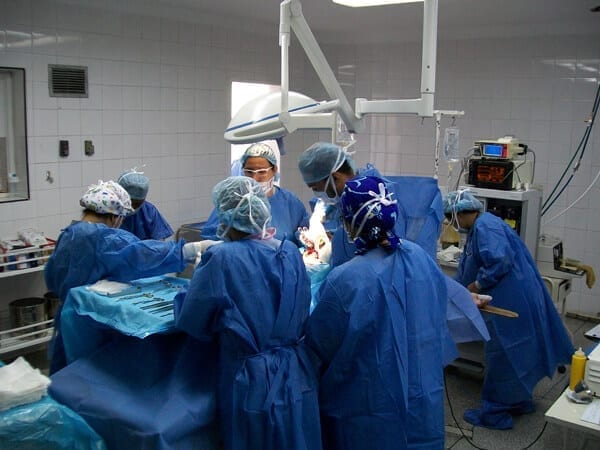Chennai, India
This woman in labor is not my patient. But the nurses worriedly tell me that the baby’s heartbeat could not be localized. Both handheld Doppler machines had broken down in the labor room unit of our small tertiary hospital. I was the resident on duty.

I use the Pinard’s stethoscope, my face parallel to the young woman’s abdomen. I hear uterine soufflé, hollow, somewhat like whispering bellows. No heartbeat.
By now the entire labor room team was assembled around us in a circle. I strain to hear a heartbeat even though the room is quiet, the only sounds being the muted murmur of voices and the rush of piped oxygen. I see the young woman’s face behind the oxygen mask and see the panic mirrored from mine. I shake my head.
“Put the Cardio on,” I say.
“Get Dr. S on the line,” I add quietly.
The cardiotocographic (CTG) machine is connected; again, the lone uterine soufflé blows as if in a desolate wail; I don’t hear the reassuring, loud, triumphant thrum of a baby’s heart beat. In frantic attempts to get a fetal trace, a nurse places the probe all around the patient’s abdomen. The CTG machine remains silent. The loud crackle of the probe against skin grates harshly on my ears, and then, suddenly, there is a faint beat. The CTG machine shows a 110 count for a brief second and then stops abruptly.
“Prepare,” I order. The radiologist on duty had just gone off call and ultrasound was out of the question.
Quickly, an intravenous line is inserted, blood is drawn for matching. A Foley’s catheter is soon inserted and her abdomen swabbed with Betadine solution. The young woman lies there with her tumescent abdomen draped in a sterile sheet, spots of yellow Betadine soaking through, wearing an oxygen mask. Her troubled eyes meet mine and I struggle to maintain my composure.
“Don’t worry,” I tell her and realize how ineffectual I sound. Dr. S comes on the phone and I quickly launch into details. She is a senior obstetrician, my mentor, whom I have rarely seen shaken. I hoped one day to grow into a well-loved, wise, and compassionate OBGYN like her.
In barely ten minutes, Dr. S comes in, and the patient is soon shifted to the operating theatre. Again, there is but a feeble occasional beat. As a rule, operating when the viability of the baby is in doubt, giving a surgical scar seems unethical or even cruel. But this is a patient Dr. S has known since she was a little girl. Did she let heart decide? A decision of which reason knows nothing? She knew the odds were against her, but she made the call to go in for surgery anyway.
In about eight minutes, from skin to uterine incision, the baby is delivered. Almost lifeless, exsanguinated. A 1.2 kg, preterm female baby, APGAR score of zero. The pediatrician intubates the baby, and life saving measures commence. I place a finger that is bigger than the baby’s heart and feel for a pulse. I shake my head mutely. CPR continues.
After about fifteen minutes, we pause. The baby’s skin has now grown cold. There is no movement, no flicker of activity. It is decided that ventilation should be continued for another hour before being declared, in deference to the wishes of the family. I knew that irreversible neurological damage occurs if resuscitation measures are not successful within ten minutes. The family, though, is insistent on supportive measures being continued. The baby is shifted to the Neonatal Intensive Care Unit (NICU).
“Doctor, I am going to declare,” the pediatrician says. I nod. He extubates the baby. There is no spontaneous respiration.
I had scrubbed for the surgery, but the moment the baby was born, I had chosen to assist in the resuscitation. And now in the NICU, the baby, bagged and connected to the ventilator, seems no more alive than at birth. Beeps continually go off, striking an ominous knell. An overwhelming sadness envelopes me.
The baby did not even have a chance. I look at it, the baby, her. Pale, delicate, still and limbs unmoving, by her sides. Who knew what she could have been?
This baby could have been someone, I think. A person. Not this wax-like doll in repose.
A tall man in a denim shirt with horn-rimmed glasses enters the room. He joins me and we stand vigil around the baby in silence. He looks calm. For what seems like the longest time we watch the baby looking for some movement, chest rise, anything. It occurs to me then, in growing awareness, that the man standing next to me is the baby’s father.
I gently take the baby’s tiny foot in my hand and stroke the sole with a thumb.
“Can I touch her? Is it ok?”
The man turns to me and asks my permission. A sharp lightning like pain flashes in my head—I don’t trust myself to speak: I nod. He takes the baby’s foot in his hand—the span of his hand the length of the baby’s leg. I almost cry and turn away: with utmost gentleness he holds the baby.
I leave him and the baby locked in a silent communion.
All around us, monitors beep, people mill about. In that moment, however, it was as if the man and his baby were all that existed—his unspoken grief, his trembling hands, and his cradled, lifeless baby. The tears, I know, will come later.
SUKANYA SAM, MBBS, DGO, DNB is a specialist in Obstetrics Gynecology with a keen interest in human nature and literature. She lives in Chennai, India.

Leave a Reply